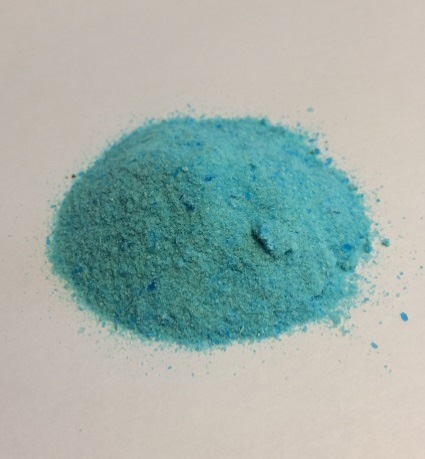Copper Sulfate – An Often Overused Chemical in Pond Management
As the least costly aquatic herbicide, copper sulfate pentahydrate (Figure 1) is widely used for short-term management of algae. It is ineffective in the long term unless combined with other management methods. Both filamentous and planktonic algae are simple plants with the capacity to rapidly reproduce and become overabundant. They can grow back quickly following herbicide applications.
Copper is seldom effective against weeds other than algae. Be certain of the identity of any aquatic weed before selecting a herbicide.
Many local farm stores and online supply sources keep copper sulfate crystals (aka “bluestone”) on hand. Copper-based liquid aquatic herbicides offer some advantages but are a more expensive alternative.
If copper sulfate or other herbicides are the only management tool used on algae, it typically grows back rapidly. When algal cells die, they break open releasing phosphorous into the water column. Light penetration into the water column increases. Surviving algal cells find this ideal for their reproduction and a new algal bloom quickly returns.
Be certain you have a problem plant that will respond to copper sulfate before deciding to use it. Work with the local Extension educator or other qualified professional to identify the problem plant and determine a prudent application rate.

Figure 1. Copper sulfate crystals can be fine or coarse.
- The greatest risk to fish from the use of copper sulfate is killing too much plant material at one time. Decay of plant material uses scarce dissolved oxygen, leading to fish suffocation. Fish treated with copper sulfate at approved rates are safe for human consumption with zero withdrawal time.
- Fish kills due to direct toxicity of copper sulfate happen occasionally. The toxicity of copper varies with Total Alkalinity (the concentration of calcium carbonate equivalents). For this reason, an OSU Irrigation Water test is recommended so Total Alkalinity can be determined and a prudent copper application rate determined.
Application rates at present are calculated based on a one-size-fits-all equation:
- (Total Alkalinity/100) X 2.7 pounds CuSO4 per acre foot of water volume
- Where acre feet = (surface square feet/43,560) X average depth in feet
Research is underway to develop rates for individual fish species. Rainbow trout, koi carp and striped bass are more sensitive to levels less than the calculated rate, while channel catfish and largemouth bass are at much less risk, being able to tolerate levels well above the calculated rate.
General advice on use of aquatic herbicides can be found in Extension publication L-466, Aquatic Herbicides: Essential Information for New Applicators.
Dealing with an aquatic plant problem almost always requires more than one management practice over multiple years. Additional measures to be considered in combination with copper sulfate include:
- Reduce nutrient runoff into the pond:
Chemical fertilizer runoff from lawns or agricultural fields
Animal wastes from livestock corrals
Unmaintained septic systems
Seek advice from the local Extension educator or other authority if you think any of these problems exist in your pond’s watershed.
- Use aquatic dyes, such as Aquashade®
Dyes reduce submerged plant growth by limiting light. These are widely used in golf course ponds. Dyes must be reapplied as the label directs, perhaps three times per year and whenever there is a large overflow. Some drawbacks include the different appearance of the water and a reduction in the food supply for pond fish. It may be necessary to reduce fish numbers in order to avoid having thin, underfed fish.
- Drain and completely dry the pond bottom.
Older ponds may have a thick layer of black organic matter on the pond bottom. Phosphorous is often released from this layer, leading to excess growth of algae. Draining and drying the pond will allow this layer to break down though aerobic decomposition.
- Allow higher aquatic plants to reestablish in the pond.
Overuse of aquatic herbicides or severe drawdowns during droughts may have eliminated “higher” aquatic plants– those with leaves and stems. Algal overabundance may be happening because of the lack of competition for light and nutrients. Ponds with moderate amounts of higher aquatic plants likely experience fewer problems with excess phytoplankton or filamentous algae.
Choose only those measures which fit the pond circumstances and the owner’s preferences.
Marley Beem
Assistant Extension Specialist, Natural Resources and Aquaculture
